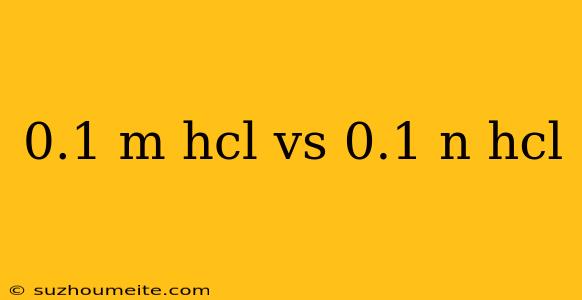0.1 M HCl vs 0.1 N HCl: Understanding the Difference
In chemical laboratories, hydrochloric acid (HCl) is a commonly used strong acid in various applications, including titration, acid-base reactions, and chemical synthesis. When working with HCl, it's essential to understand the difference between 0.1 M HCl and 0.1 N HCl, as they represent different concentrations of the acid.
What does "M" and "N" mean?
In chemistry, "M" stands for molarity, which is a unit of concentration that represents the number of moles of a solute per liter of solution. Molarity is denoted by the symbol "M" and is calculated using the following formula:
Molarity (M) = Number of moles of solute / Liter of solution
On the other hand, "N" represents normality, which is another unit of concentration that is based on the number of equivalents of a solute per liter of solution. Normality is denoted by the symbol "N" and is calculated using the following formula:
Normality (N) = Number of equivalents of solute / Liter of solution
0.1 M HCl vs 0.1 N HCl
Now, let's compare 0.1 M HCl and 0.1 N HCl.
0.1 M HCl
A 0.1 M HCl solution contains 0.1 moles of HCl per liter of solution. This means that for every liter of solution, there are 0.1 moles of HCl present.
0.1 N HCl
A 0.1 N HCl solution contains 0.1 equivalents of HCl per liter of solution. Since HCl is a monoprotic acid, one mole of HCl is equivalent to one equivalent. Therefore, a 0.1 N HCl solution is equivalent to a 0.1 M HCl solution.
Key Takeaways
- 0.1 M HCl and 0.1 N HCl have the same concentration of HCl, but they represent different units of measurement.
- Molarity (M) is based on the number of moles of a solute per liter of solution, while normality (N) is based on the number of equivalents of a solute per liter of solution.
- When working with strong acids like HCl, it's essential to understand the difference between molarity and normality to ensure accurate calculations and results.
In summary, 0.1 M HCl and 0.1 N HCl are equivalent in terms of concentration, but they represent different units of measurement. By understanding the difference between molarity and normality, you can ensure accurate calculations and results in your chemical laboratory experiments.
